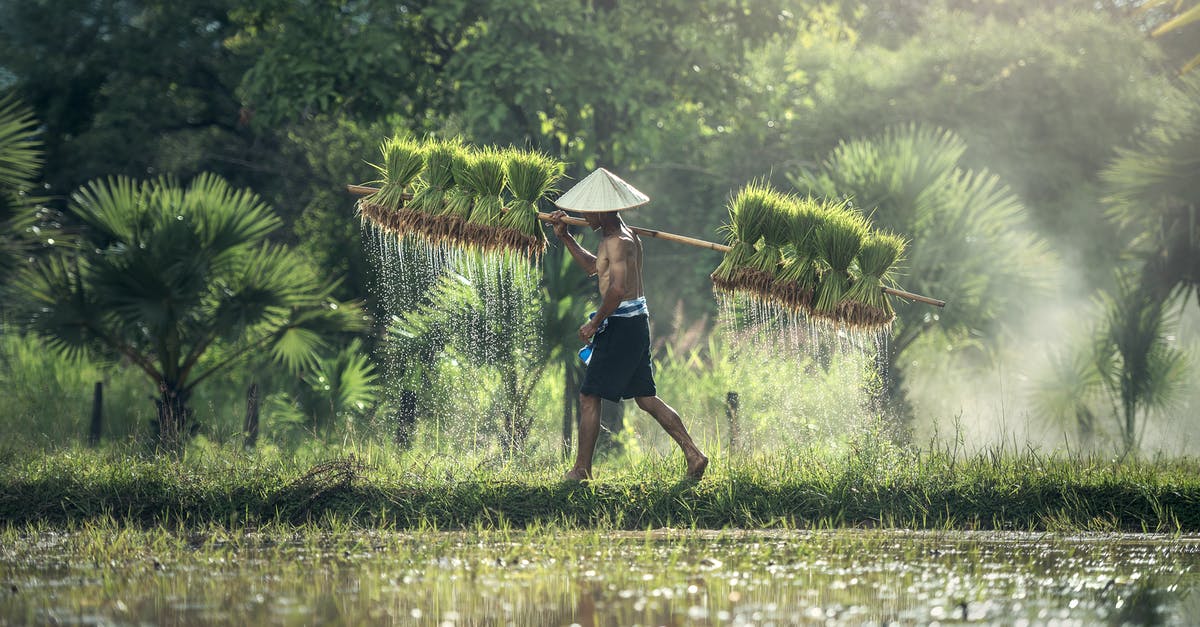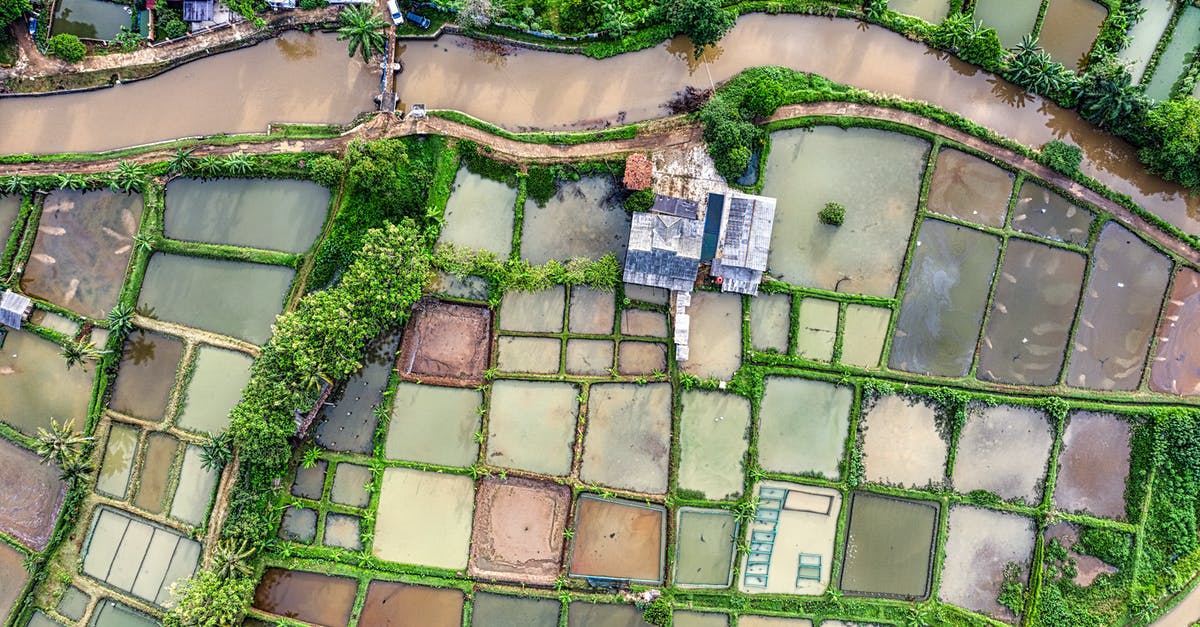What makes rice wet?

Recently I've been making rice, but my rice is always a bit moister than I'd like. Normally it is visibly wet and somewhat sticky.
My normal recipe is:
- Add a lot of water to a pan.
- Bring water to boil.
- Add rice.
- Move lid to be partially on.
- Keeping the water boiling. (Fairly large bubbles, ~2")
- Ten minutes later drain water.
However in an attempt to get 'perfect' rice I tried another recipe I found online:
- Add water to be ~1cm above rice.
- Bring water to boil.
- Add rice.
- Keep lid fully on.
- Keep water boiling. (Small bubbles, ~1cm)
I messed up here as it should have been simmered, but I messed up the temperature.
- Ten minutes later drain water. (There wasn't really any)
This new recipe caused the rice to be very wet, to the point that the next day the rice was, pretty much, useless at making egg-fried rice.
My rice is long grain rice, which has been double water polished.
How can I change my recipe to make dry rice?
What causes the rice to become wet, and how can I ensure this doesn't happen?
Best Answer
I'm going to copy/paste my answer from https://cooking.stackexchange.com/a/93753/42066 because I still disagree with the usual methods posted...
TL:DR - use less water, allow 'drying time' afterwards.
I'm going to go contra to pretty much all the advice so far, but this is how I've been cooking rice for 25 years...
Clear-lidded pans make this far less guesswork.
Use a heavy-bottomed saucepan with a tight-fitting lid, 3 times the volume of your finished rice.
Don't rinse the rice, you don't need to.
Use your coolest, most even burner - this is not necessarily the smallest. Sometimes the tiny ones generate bad hot-spots that a medium one wouldn't.
Boil the kettle.
Pre-heat the pan on high.
Add rice to your pre-heated pan. Salt as required.
Immediately add 1.75 x the volume of water, not double.
late addition - this is a 'learned' variable, dependant on the solidity of your pan & how low you can get the burner. It could be as low as 1.6x if you have a very heavy pan & a good low heat.
That should immediately hit a rapid boil because of the pre-heating.
Stir once, just enough to ensure the grains are separated.
Drop the heat to minimum [on gas this is near instantaneous, you might need to wait a second on electric]
Put the lid on.
The contents should foam almost to the top but not go over - lift & replace the lid if it looks like it will go over, otherwise leave alone.
Simmer at this minimum temperature for 12-15 mins [depends how low you can get the heat]
Don't lift the lid to "see if it's done". Learn when it's done by repetition.
'When it's done' btw, is when all the water is gone; you might be able to hear a slight crackle as the last bit dries.
After the required time, switch off the heat, leave the lid on.
Allow to rest for another 15-20 minutes.
Fluff briefly with your spatula; no great effort should be required at this stage.
Serve.
The rice will be separate & fluffy, none will be stuck to the bottom.
This works for pretty much any rice type - long grain, basmati, or short-grain, glutinous [short grain, of course, will not separate in the same way].
*Almost copy/paste from my own answer at https://cooking.stackexchange.com/a/93672/42066
I must add, this is for 'white' rice types - standard long grain, patna, basmati, jasmine, & even mixes or pre-frys like Turkish orzo/rice etc. It even includes bulgar. [It excludes quick-cook or par-boiled, as I never use those]
I also never cook brown rice so have no ratios in my head & I'd have to look it up or read the pack. Risotto, of course, you just keep adding more until it's done ;)
Late edit
I only just noticed the purpose is for fried rice - in which case the last step is to allow it to cool completely then put the pan in the fridge overnight. If you have the method correct so far, then tomorrow it will separate even more & be just right to stir-fry.
Pictures about "What makes rice wet?"



Quick Answer about "What makes rice wet?"
Mushy or soggy rice is simply overcooked rice that has absorbed too much water. Water over-absorption causes the rice grains to split open, ruining the texture and creating a starchy, gummy result.Why is my rice so wet?
If your rice has absorbed too much liquid, the grains may have split and the starches may have given the rice a soft, gluey consistency. One way to fix that? Add even more liquid. Pour in some milk, a dash of vanilla, and spoonful of sugar, and suddenly your mushy rice is a rich rice pudding.How do I stop rice from being wet?
Remove your pan from heat and uncover, placing a kitchen towel (as described above) over pan to keep moisture from dripping onto rice. Cover the pan tightly with lid. Let rice stand, covered, for 15-20 minutes to firm up. Remove the lid and fluff cooked rice with a fork.How to Fix Soggy Rice
More answers regarding what makes rice wet?
Answer 2
Uncover the pot and cook over low heat to evaporate the water. Or gently turn the rice out onto a baking sheet and dry it in a low oven. I also will pan-fry the rice in a non-stick pan to give it a drier appearance and seal the outside of the rice.
Answer 3
This is how I cook my rice every time, typically brown - sometimes white or yellow. Each grain (of rice) is cooked, but separate, and tender. All of the water is absorbed. No burning or scorching.
- Measure 1C uncooked rice into saucepan. [No rinsing beforehand.]
- Add 2C water, a dash of salt and a smidge of butter (~1 tsp).
- Place the pan (with lid) on a burner.
- Set the burner on Medium.
- Set the timer for 30 minutes. [If steam or liquid escapes, lift the lid and immediately replace it. Otherwise, do not open lid until the timer goes off.]
- Remove it from the heat, fluff it with a fork, and serve. [If the rest of dinner isn't ready, you can put the lid back on the pan to keep the rice from cooling off too much.]
[note: I have not experimented with more exotic rices (like Jasmine). I do not know if they require an alternate method.]
Answer 4
Yet another method for long-grain varieties, always handling carefully so as not to break the grains:
- Boil fairly vigorously in plenty of salted water, for 8 or 9 minutes, until not-quite cooked. (To the teeth, there should be no brittle snap of completely uncooked grain, but it should be a little firmer than you want to serve it)
- Strain well in a colander, but don't go over the top shaking it dry
- Gently shake/scatter the rice out into a very warm serving dish with a lid
- Cover, but under the lid put a stretched layer of paper towel, clean muslin, or anything that will prevent condensation dripping back into the rice.
- Place in a warm (85 -90) oven, and let the rice finish cooking in its own gentle heat/steam for almost as long as you like, while you prepare other parts of the meal.
If the rice is to be fried, you can just leave the rice to cool completely before refrigerating overnight.
Sources: Stack Exchange - This article follows the attribution requirements of Stack Exchange and is licensed under CC BY-SA 3.0.
Images: Pixabay, Yan Krukov, Tom Fisk, Quang Nguyen Vinh
